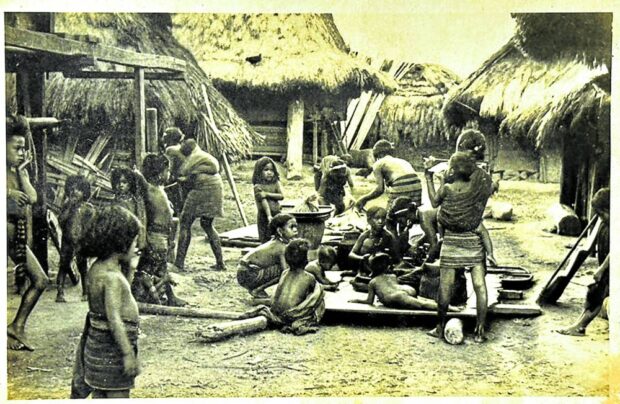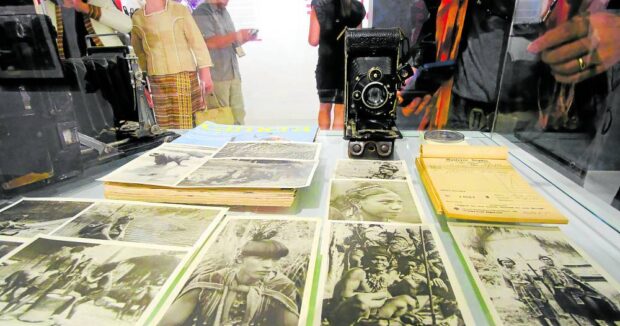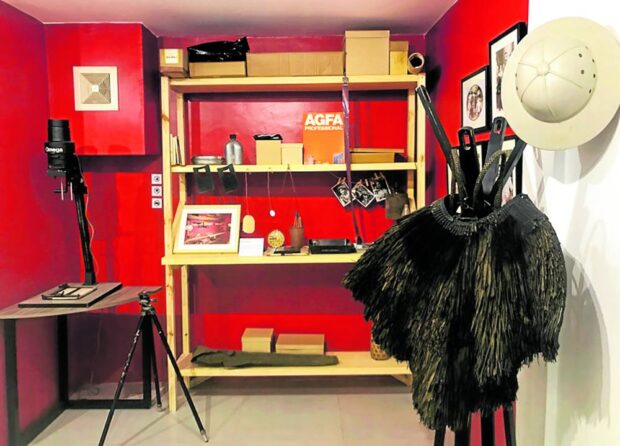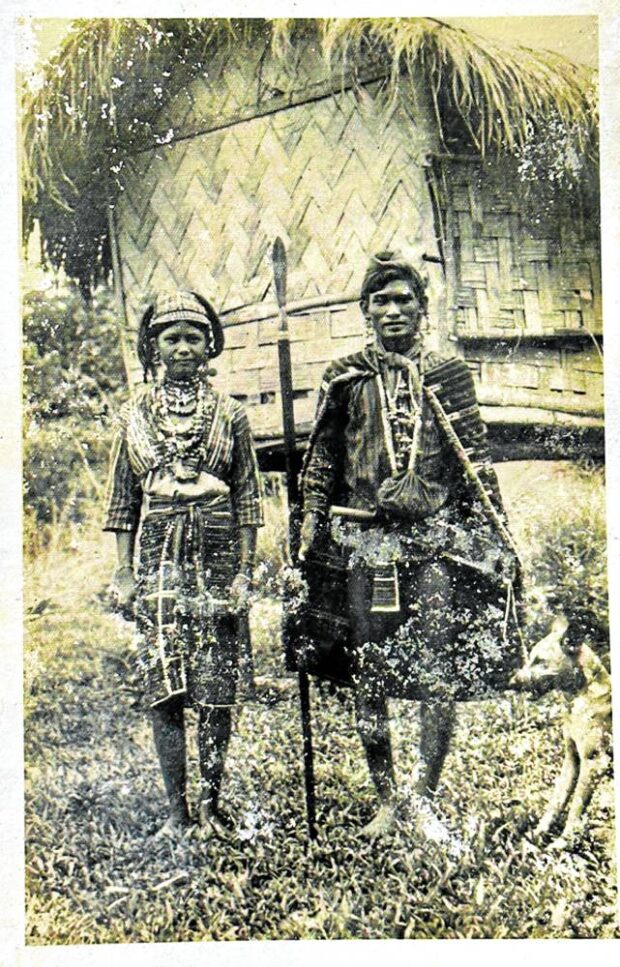Vintage Masferré postcards rescued from trash draw attention at exhibit

EARLY CORDILLERA LIFE | Eduardo Masferré helped provide a window to American colonial and postwar Cordillera life through photographs and popular 1950s postcards which he collected by
visiting mountain villages and interacting with local communities and immersing himself in their culture. (From the postcard collection of JOEL ARTHUR TIBALDO)
BAGUIO CITY, Benguet, Philippines — Vintage postcards by the late master photographer Eduardo Masferré which were rescued from the trash in the 1980s drew as much attention as his world-famous prints that went on exhibit last week as part of this year’s Ibagiw Creative City Festival.
One of the postcards brought in a scrapbook on Nov. 17 by Joel Arthur Tibaldo features a young Igorot woman smoking a pipe, which is also displayed in the exhibit at the Baguio Convention and Cultural Center. Another card shows a young woman carrying a jar, which was marked “Number 49” with a pen and was stamped with the phrase “Eduardo Masferré Bontoc, Mt. Prov.”
Tibaldo’s family used to buy scrap paper trimmings, and he found the Masferré treasure trove after rummaging through piles of old books and letters in a garbage box from the Easter Weaving Room in the summer of 1982.
Tibaldo, a retired government employee and journalist said he just realized that he could have used the Masferré images to depict the old Mountain Province in his thesis for his Bachelor of Fine Arts degree at the University of Santo Tomas which he completed in March 1982.
Tibaldo showed the postcards to Masferré’s fourth child, Francisco “Pancho,” at the exhibit and told him the American colonial-era photographer had been one of his biggest influences.
Article continues after this advertisement
His iconic photographs and his cameras are on exhibit at the Baguio Convention and Cultural Center until January.
READ: The painter as political chronicler
Asserting control
Masferré’s works are arguably the most “pirated” Filipino photographs in recent memory.
Article continues after this advertisementSome of his most recognizable prints have been silk-screened on shirts and used as décor or advertising materials back in the 1980s and 1990s, prompting the Masferré children to assert control over their father’s legacy.
Masferré was born in the Mountain Province town of Sagada on April 18, 1909, during the first decade of American colonial rule and the year Baguio was opened as a chartered city.
At the time, the Cordillera countryside was an object of global curiosity, partly due to images by American photographers and historians like United States Secretary of the Interior Dean Conant Worcester, who ventured out to the mountains to document the lives of “wild” people in the Philippines. The existence of indigenous Filipino communities justified an American colonial point of view that Filipinos needed to be pacified and civilized.
But for the past decades, the vast collections of photographs taken by Masferré and Worcester and, much later, by younger photographers like the multi-awarded Tommy Hafalla, who pursued his subjects like an anthropologist, have been heavily scrutinized for details about the Igorot and their way of life.
“While the photographs are handsome depictions of the Cordillera people as they go about their daily lives,” Masferré had chosen to paint a more authentic — thus “truthful” — recording of the Cordillera, according to Roland Rabang, a University of the Philippines Baguio assistant professor on language and literature.
Rabang has been researching Masferré’s life and helped put up the exhibit with UP Baguio anthropology professor Analyn Salvador-Amores.

FAMILY STORIES Francisco “Pancho” Masferré’s stories and his recollection of the life of his father,
Eduardo Masferré, helped the exhibit recreate the master photographer’s Mountain Province
workspace. —NEIL CLARK ONGCHANGCO
READ: A last shot of Baguio coffee
Rapid changes
Masferré was a son of a Spanish Catalan soldier, Jaime, who decided to stay at the end of the 1898 Spanish-American War, and a Kankana-ey woman named Kunyap, who took the Christian name Mercedes.
In the 2009 critical analysis of Masferré’s and Hafalla’s photographs, Rabang said Masferré perceived his subjects as “a different life from elsewhere” which he strove to portray each time he visited villages in the Cordillera mountains.
He said the 1930s were a “pivotal time” for Masferré who was astonished at the rapid changes occurring in the mountains where he lived.
“Roads were being built for motor vehicles, replacing horse and foot trails. Suddenly, the Cordillera was no longer the isolated and remote place it was thought to be … Masferré’s work had to race against these changes,” Rabang wrote.
Masferré, who died in 1995, elaborated on this perspective in a 1988 book that was cited by Rabang.
“I could see there would be a time when the [Cordillera] life would disappear … Almost everything was changing. The houses, for instance, were beginning to be made of galvanized iron because the old houses were hard to make and more expensive … In the matter of clothes, a pair of trousers was cheaper than a G-string and, moreover, it had pockets,” Masferré had said.
At the exhibit launching, Pancho described his father as a “self-taught photographer,” who read photography books and early 20th century magazines to understand the art.

RESCUED | These are among old postcards rescued by Joel Arthur Tibaldo from piles of discarded
paper from the Easter Weaving Room in Baguio City in the 1980s. They bore the “Eduardo Masferré” brand which was stamped on the back.
READ: ‘What’s so special about these photos?’
‘Cultural hero’
Masferré had spent his early childhood in Barcelona but completed high school in Baguio when Jaime brought him back to the country.
After briefly teaching at a local school, Masferré ordered a box camera and photo-developing chemicals by mail and began hiking out to the mountains, Pancho said.
Rabang wrote: “Pancho says an American friend Kip Moore, who was manager of Baguio’s defunct Heald Lumber, sometimes accompanied Masferré on these trips; the team subsequently befriended the people, gave them back pictures taken on previous trips and set up camp for three to five days [to take photos]. Masferré went about these trips with full provisions, Pancho says.
That meant he brought food as well as his tent, [and] gradually the locals invited him to their houses to partake of their meals.”
Masferré put up a commercial studio in Bontoc town, now the capital of Mountain Province, but he eventually moved his workplace back to Sagada, which Rabang had recreated for the exhibit, complete with Masferré’s reading materials and vintage cameras.
Rabang said Masferré continued to take photographs until the 1980s, but he had “slowed down his documentation of the Cordillera beginning in 1956” because of the modernizing landscapes.
Masferré’s photographs describe a Cordillera to which he was accustomed: “Terraces, thatched roofed huts, bare-breasted women, men with spears, shields and head-axes, women pounding rice, planting rice, winnowing rice, and other typical depictions of the place and its peoples.”
One of Masferré’s typical prints was the 1936 portrait of “Pecdasen of Sagada,” which shows a tobacco pipe chained to his head gear while a “lingling-o” (ancient pendant) dangles from his left earlobe.
Masferré had made no references to “preserving a vanishing heritage when he began his photography in the Cordillera.”
However, modern scholars now recognize “his foresight and for documenting a long-gone cultural legacy,” Rabang noted.
“For this, he is hailed as a cultural hero,” Rabang said.